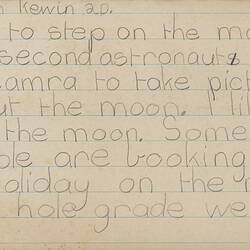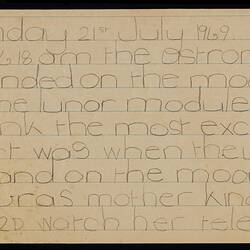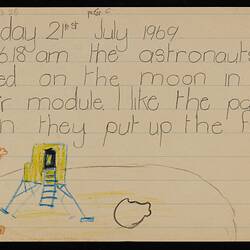Summary
Two sheets of grade 2 student work, lined, written in pencil. The work records the landing of the first humans on the moon on 20 July (21 in Australia) 1969.
The work is inscribed: 'Susan Kewin 2D. Monday 21st July 1969. At 6.18am. the astronauts landed on the moon in the lunar module. Their is no air on the moon just dust and rock their is no water on the moon either. Nothing lives on the moon. This is exciting. But their still in their lunar module. Just before our grade went over to Debra's house to see what was the three astronauts were doing on the moon. Now I saw that Neil Armstrong was the first man to step on the moon. The second astronaut took his camra to take picture's about the moon. I like see the moon. Some people are booking for a holiday on the moon. The hole grade went to Mrs Olds house. Some people were late I were early.' [Original spelling]
The donor was a school teacher at Altona Primary School, and the work was done under her supervision at the time of the landing.
Physical Description
Two sheets of off-white paper, lined in blue with wide spacing for a young writer, written in pencil on both sides in careful, rounded writing. The rear of the first page includes a small coloured drawing of a sun and earth. Originally stapled together - staple now missing. Small loss at lower right of first sheet. Paper yellowed and slightly foxed.
Significance
It is estimated (by SBS) that around 500 million people around the world watched the moon landing on 20 July, 1969. The moment Neil Armstrong stepped onto the moon was one of the iconic moments in modern history. He was joined on the surface by Edward ('Buzz') Aldrin, while Michael Collins remained in the orbiting command module. A total of six lunar landings were achieved in three years, the last in December 1972.
The way that children experienced and remembered the event is not well-documented. In an era of few televisions, many school children saw the moon landing on televisions set up in school corridors or crowded classrooms, or were invited to local homes that had televisions. In her Grade 2 class at Altona Primary School, Mrs Klemm asked her pupils to record their thoughts and impressions as the landing occured, and kept several examples for posterity, together with the newspaper that recorded the lunar landing. She was probably one of countless teachers around the world to use the event as an educational opportunity. The children's work records the basic facts of the event, where they saw it and what was likely to happen next. Some placed themselves in the story, imagining visiting the moon or mentioning unrelated facts such as where they had lunch that day.
The school work also offers an insignt into school life in the late 1960s at a Melbourne primary school. The Heritage Victoria listing of Altona Primary School (no. 3923) notes that it was the first school to be built in Altona (constructed 1922-27), and is one of few surviving early public buildings in Altona. The school was part of significant inter-war development of the area, stimulated by the revival of the Altona Beach estate. Altona grew quickly in the following years, from 1722 in the 1933 census to 16,167 in the 1961 census. By 1966 several portable classrooms were being used to accommodate the students, in addition to classrooms added since the school opened.
More Information
-
Collecting Areas
Childhood, Public Life & Institutions, Information & Communication, Science & Measurement
-
Acquisition Information
Donation from Ms Patricia Klem, 30 Jul 2009
-
Date Made
-
Place & Date Written
-
Inscriptions
In pencil: 'Susan Kewin 2D. / Monday 21st July 1969. / At 6.18am. the astronauts / landed on the moon in the / lunar module. Their is no air / on the moon just dust and / rock their is no water on / the moon either. Nothing live-/s on the moon. This is exc-/iting. But their still in thei-/r lunar module. / Just before our grade went / over to Debra's house to / see what was the three / astronauts were doing on / the moon. Now I saw that / Neil Armstrong was the first / man to step on the moon. / The second astronaut took / his camra to take picture's / about the moon. I like / see the moon. Some / people are booking for / a holiday on the moon. / The hole grade went to Mrs Olds house. Some people were late I were / early.'
-
Classification
-
Category
-
Discipline
-
Type of item
-
Overall Dimensions
378 mm (Width), 250 mm (Height)
-
References
Information on Altona State School: Heritage Victoria web site [Link 1] accessed 5/1/2010. 'The Moon Landing 40 Years On', SBS web site [Link 2] accessed 5/1/2010.
-
Keywords









